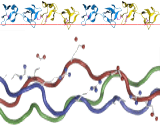Type-II collagen is the basis for articular cartilage and hyaline cartilage.It makes up 50% of all protein in cartilage and 85-90% of collagen of articular cartilage.Type II collagen does form fibers. This fibrillar network of collagen allows cartilage to entrap the proteoglycan aggregate as well as provide tensile strength to the tissue. Type II collagen, which adds structure and strength to connective tissues, is found primarily in cartilage, the jelly-like substance that fills the eyeball (the vitreous), the inner ear, and the center portion of the discs between the vertebrae in the spine (nucleus pulposus). Three pro-alpha1(II) chains twist together to form a triple-stranded, ropelike procollagen molecule. These procollagen molecules must be processed by enzymes in the cell. Once these molecules are processed, they leave the cell and arrange themselves into long, thin fibrils that cross-link to one another in the spaces around cells.

